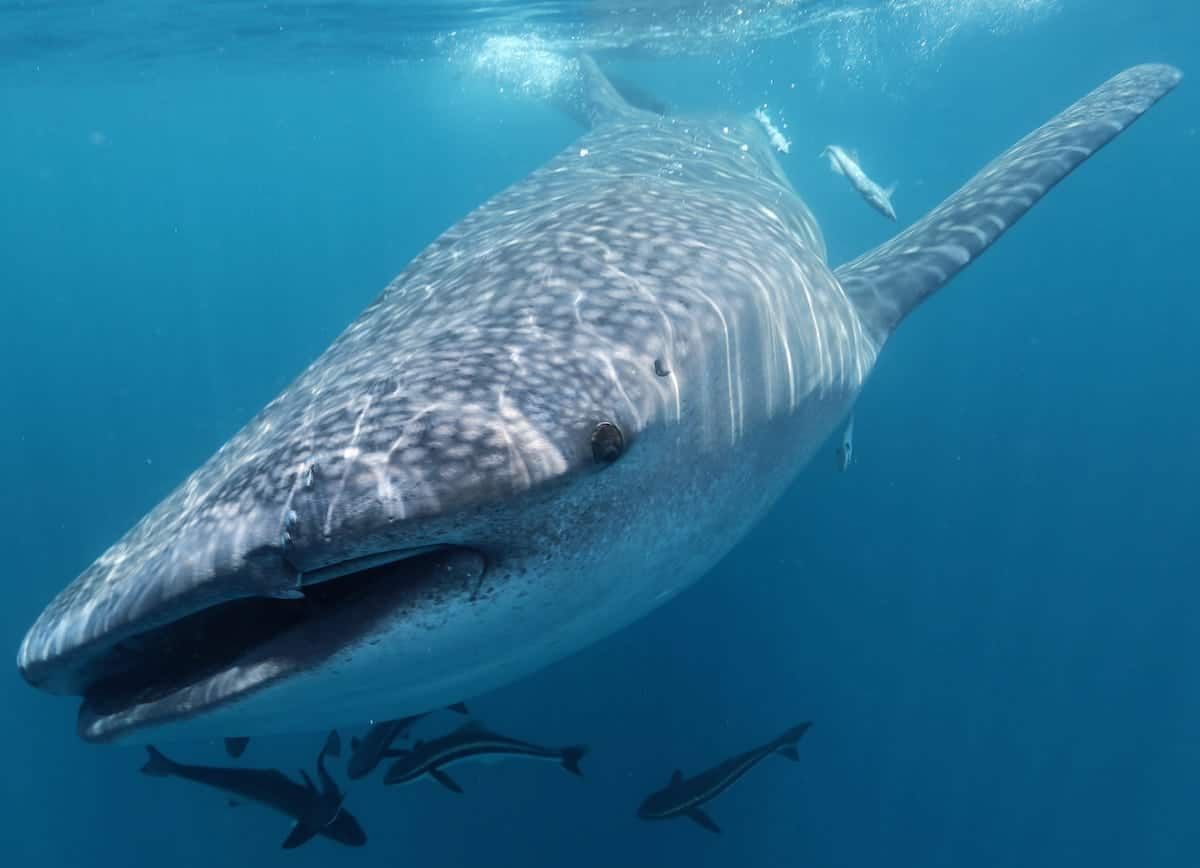
A female whale shark has travelled more than 12,000 miles in the longest migration ever recorded.
The gentle giant, called Anne, was tracked by researchers from the Smithsonian Tropical Research Institute from the eastern Pacific to the western Indo-Pacific for 20,142 kilometers.
Whale sharks have been tracked for shorter distances along similar routes, but this is the longest-recorded migration to date and the first evidence of a potential trans-Pacific route.
Anne remained in Panamanian waters for 116 days, then swam toward Clipperton Island, nearing Costa Rica’s Cocos Island en-route to Darwin Island in the Galapagos, a site known to attract groups of sharks.
After 266 days of being tracked, the signal disappeared, indicating that Anne was swimming too deep to track.
The researchers then had 235 days of silence before transmissions started again south of Hawaii.
After a nine-day stay, she continued through the Marshall Islands until she arrived at the Marianas Trench – a canyon in the ocean floor where movie director James Cameron located the deepest point on the Earth’s surface almost 11,000 meters below sea level.
Whale sharks can dive to more than 1900 meters (6000 feet). But it is unknown what Anne was doing in this area.
Anne was first tagged by marine biologist Dr Héctor Guzmán near Coiba Island in Panama.
He said: “We have very little information about why whale sharks migrate, are they searching for food, seeking breeding opportunities or driven by some other impulse?”
Genetic studies show that whale sharks across the globe are closely related, suggesting that they must travel long distances to mate.
Like Anne, other whale sharks appear to follow the North Equatorial Current for most of the distance.
Large females can swim an average of 67 kilometres (about 40 miles) per day and can reach 12 metres (40 feet) in length.
Co-author and biology professor at Principia College Dr Scott Eckert said: “Despite being the world’s largest fish, it’s amazing to me how little we know about this species.
“When I first began working on them, their taxonomy was debated, and it still wasn’t clear how they reproduced.”
Dr Guzmán estimated Anne’s position based on signals from a Smart Position and Temperature (SPOT) tag tethered to the shark and received by the Advanced Research and Global Observation Satellite (ARGOS).
The tag only communicates with the satellite when the shark swims near the surface.
The multi-year project also tagged 45 other sharks in Panama.
The team named shark Anne for conservationist Anne McEnany, president and CEO of the International Community Foundation (ICF).
The endangered species is normally found in warm, tropical and sub-tropical waters. It’s thought that about a quarter of whale sharks live in the Atlantic, whereas about three-fourths live in the Indo-Pacific.
Some sites around the world are known to attract groups of more than 500 whale sharks. This includes in Oman, Australia, Galapagos and Mexico.
Large groups are also reported from Taiwan, Southern China and the Gujarat coast of India.
The plankton feeders are not considered to be particularly dangerous but often attract tourists and fishing boats.
They are sought after for their fins, meat, teeth, cartilage and oil with purported medicinal value.
Juvenile whale sharks often end up as bycatch in tuna and other fisheries.
In many parts of the world, whale sharks have legal protection, but regulations are often not enforced.
Dr Guzman’s data were used to design and draft local and regional policies for the protection of the species.
He said: “Whale sharks in Coiba have already changed their behaviour to avoid the surface and tourists.
“These studies are critical as we design international policy to protect trans-boundary species like the whale sharks and other highly migratory marine species.”
Whale sharks were classified as endangered in 2016.
During the past 75 years, it is estimated that nearly half of the world’s whale sharks have disappeared.
The report called Longest recorded trans-Pacific migration of a whale shark (Rhincodon typus) was published in Marine Biodiversity Records.
https://www.thelondoneconomic.com/news/incredible-once-in-a-lifetime-moment-a-british-swimmer-came-across-a-2000-strong-shoal-of-very-rare-rays/19/04/
https://www.thelondoneconomic.com/news/environment/polar-regions-have-become-temporary-sink-for-billions-of-microbeads-from-cosmetics-packaging-paints/24/04/